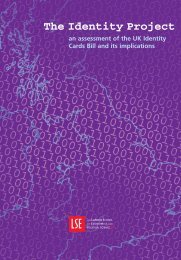Money Laundering: Review of the Reporting ... - Dematerialised ID
Money Laundering: Review of the Reporting ... - Dematerialised ID
Money Laundering: Review of the Reporting ... - Dematerialised ID
You also want an ePaper? Increase the reach of your titles
YUMPU automatically turns print PDFs into web optimized ePapers that Google loves.
kpmg<br />
<strong>Review</strong> <strong>of</strong> <strong>the</strong> regime for handling Suspicious Activity Reports<br />
Report <strong>of</strong> recommendations<br />
KPMG LLP<br />
maximum benefit is derived by LEAs from <strong>the</strong>ir receipt <strong>of</strong> SARs (section 8). Section 9<br />
summarises <strong>the</strong> recommendations and sets out a proposed timetable for implementing<br />
<strong>the</strong>m.<br />
1.3 Appointment <strong>of</strong> KPMG<br />
1.3.1 KPMG were appointed to review and report on <strong>the</strong> effectiveness <strong>of</strong> <strong>the</strong> regime for<br />
handling SARs on 15 November 2002. This followed a successful application by NCIS<br />
to <strong>the</strong> Recovered Assets Fund (“RAF”) for funding for this review.<br />
1.3.2 We conducted a review <strong>of</strong> a pilot sample <strong>of</strong> SARs and designed a questionnaire for<br />
completion by attendees at <strong>the</strong> National Financial Investigators Conference in November<br />
2002. Our detailed work programme was <strong>the</strong>n set out in a variation to <strong>the</strong> initial<br />
engagement letter dated 23 January 2003 following discussion with ECB and <strong>the</strong> Project<br />
Management Panel (“PMP”) 1 <strong>of</strong> <strong>the</strong> results <strong>of</strong> <strong>the</strong> pilot phase at its meeting in December<br />
2002.<br />
1.3.3 The key elements <strong>of</strong> our fieldwork prior to producing our report were agreed to be:<br />
• Tracking a sample <strong>of</strong> 200 SARs from disclosing institutions to identify <strong>the</strong> processes<br />
and timing from recognition <strong>of</strong> a suspicious transaction to submission <strong>of</strong> <strong>the</strong> SAR to<br />
NCIS.<br />
• Conducting a survey <strong>of</strong> <strong>the</strong> key work stages at ECB (input, validation and<br />
dissemination).<br />
• Tracking a sample <strong>of</strong> 600 SARs sent by ECB to LEAs to assess <strong>the</strong>ir ultimate<br />
outcome.<br />
• Obtaining detailed responses to questionnaires from 62 entities which provide SARs,<br />
including <strong>the</strong> 12 which provided those identified in <strong>the</strong> initial sample <strong>of</strong> 200, and <strong>the</strong><br />
57 LEAs which handle <strong>the</strong>m.<br />
• Following up and validating our fieldwork through meetings and workshops.<br />
1.4 Objectives <strong>of</strong> report<br />
1.4.1 The invitation to tender document noted that <strong>the</strong> UK Asset Recovery Committee (“ARC”)<br />
wished to commission “an independent review <strong>of</strong> <strong>the</strong> process used in <strong>the</strong> UK for <strong>the</strong><br />
handling and dissemination <strong>of</strong> STRs.” It stated that <strong>the</strong> key objective <strong>of</strong> <strong>the</strong> report was to<br />
1 The Project Management Panel was established as a forum for KPMG to report back to<br />
stakeholders and interested parties on <strong>the</strong> progress <strong>of</strong> our work and to allow informed discussion <strong>of</strong><br />
our initial and interim findings.<br />
jo/fh/519 8









